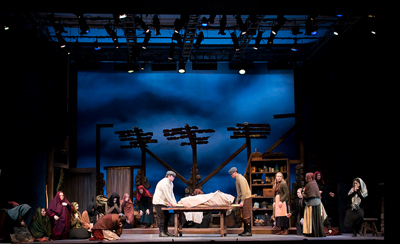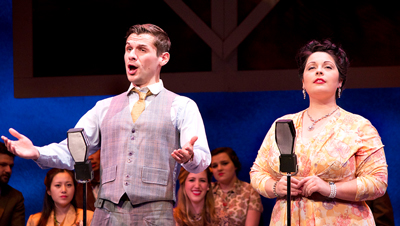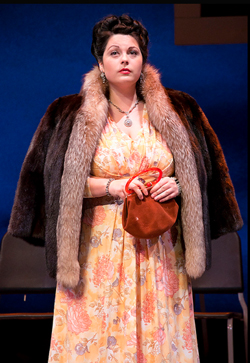by Mike Telin

In his director’s notes David Bamberger pointed out that both operas center on a powerful woman and in each case, that woman self-identifies through a man – in one case a mother, in another as a lover. And in each opera the woman loses the man to rival forces that she can neither control nor totally understand. But without a doubt, the pairing of these two titles made for a fun, enjoyable and thought-provoking evening. Enjoyable because of the outstanding performances given by the young and talented CIM cast. Thought-provoking due to an ingenious take on an all too-familiar tale. I attended the Thursday, February 27 performance.
Set in a cottage on the Aran Islands off the west coast of Ireland around 1900, Vaughan Williams’s opera is based on the J.M. Synge one-act play of the same name. When the opera begins, we find that the elderly wife and mother, Maurya, has already lost her husband, father-in-law, and four of her six sons to the hands of the brutal sea. Her daughters, Nora and Cathleen, receive word that a body, presumably their brother Michael, has washed ashore. All the while Maurya’s sixth and last son, Bartley, is preparing to go to Galway to sell horses. But soon his life has also been taken by the sea. Maurya, in a state of anguish, laments: “They are all gone now, and there isn’t anything more the sea can do to me.”
Mezzo-soprano Erika Rodden brought heart-wrenching despair to the role of Maurya, her voice resonating with a hauntingly dark quality. Sopranos Zoe Schumann and Kate Kostopoulos portrayed the daughters, Nora and Cathleen respectively, with concerned compassion. And baritone Jose Vazquez brought the appropriate air of invincibility to the role of Bartley. Megan Thompson and the chorus (The People of the Village) rounded out this excellent cast.
David Bamberger’s staging, while simple, was completely effective, although at times, mainly when upstage, some of the voices were momentarily lost. The CIM Orchestra under the direction of Harry Davidson were in fine form and there were many distinguished wind solos. The opera was preceded by well-balanced performances of Two Pieces from Henry the V by William Walton. Perhaps not necessary, but nonetheless, a fitting prelude to the opera.
Based on Virgil’s Aeneid, Henry Purcell’s Dido and Aeneas tells the story of the love that Dido, Queen of Carthage, has for the Trojan hero, Aeneas, and the complete despair she suffers when he abandons her at the behest of the gods in order to cross the sea to establish the foundation of the Roman Empire. Her suffering is so intense that it causes Dido to take her own life.
I must admit that while I have enjoyed many productions of the opera, I have always had a problem wrapping my head around the plot. First, does Dido really take her own life because Aeneas leaves to establish the Roman Empire? Secondly, Dido is exhibiting signs of depression from the beginning of the opera: the first line she sings is “I’m pressed with torment.” So why doesn’t Belinda insist that she seek counseling? Although Bamberger leaves Purcell’s masterpiece untouched, he has come up with an inventive solution for us 21st century types to find modern relevance in an old story. And he leaves us with something to think about.
Set in a late 1930’s recording studio, the Record Producer (Armando Contreas) tells the live audience that a once-through recording of Dido and Aeneas is about to begin. Lucrezia Corona (Elizabeth Frey) will sing the role of Dido, Lily Flexner (Jessica Hollick) the role of Belinda and Angelo Wakefield (Brian Skoog) the role of Aeneas. Other characters stepped out of the chorus, which also collectively portrayed Carthaginians, Witches and Sailors.
What made Bamberger’s concept so fascinating was the possibility of creating real-life relationships between the singers. As in the opera, Corona and Wakefield are clearly as much of an item as Dido and Aeneas – at least at first glance. And by setting the recording session in the 1930’s, Bamberger punted the issue of historical performance practice. It also allowed him to dress the cast in 1930’s garb, giving the show its own historical flavor.
As the recording session progress and characters take coffee-breaks, various pairings emerge which like in Purcell’s opera leads to Wakefield abandoning Corona. But unlike the opera, Wakefield is not called to the sea but rather to the affections of the Sailor with whom he departs arm in arm at the end. That’s a modern twist to the plot, but so is Dido’s response. Rather then offing herself in despair (or drowning her sorrows in drink), she picks herself up and leaves the studio with her head held high. That’s a radical re-interpretation of an opera that really works.
Throughout the performance Frey, Hollick and Skoog not only sang with dramatic refinement but were also utterly convincing in their personae. Ellyn Glasscock was powerful in the role of The Sorceress while Casey Gardner and Megan Thompson as the two witches were her perfect evil sidekicks. Brittney Cyphers was a sympathetic 2nd Woman and Miriam Stoner made the most of her cameo role as the Spirit. Although Purcell only gave the Sailor a brief aria, Reid Taylor made a compelling moment of his announcement that Aeneas’s ship was ready to depart. The chorus, prepared by Dean Southern, sounded splendid and Armando Conteras brought the perfect bossiness to the role of The Record Producer.
Harry Davidson and the CIM Orchestra performed with panache and excellent pit to stage coordination during the Purcell. And they gave a lively reading of the Finale of Britten’s Simple Symphony to entertain the studio audience as they waited for the recording session to begin.
Photos courtesy of CIM. (Since the operas were double-cast, images may not represent singers named in this review.)
Published on ClevelandClassical.com March 5, 2014
Click here for a printable version of this article.






